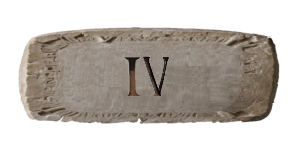Or IV in Roman Numearals

In Roman numerals, the number 4 is represented as “IV.”
It’s formed by subtracting 1 from 5, where “V” represents 5.
Roman numerals rely on a combination of letters from the Latin alphabet to represent numbers and subtractive notation is commonly used in cases like this, where a smaller numeral precedes a larger one to indicate subtraction.
Roman Numerals 1- 24
Example:
There are a few interesting things to note about the Roman numeral “4” (IV):
Subtractive Notation: The Roman numeral “4” is written as “IV” using a subtractive notation in Roman numerals.
In Roman numeral rules, you typically place a smaller numeral before a larger one to subtract the smaller numeral’s value from the larger one.
In this case, “I” (1) is subtracted from “V” (5) to represent “4.” This subtractive notation is a common feature of Roman numerals and is used to reduce the number of characters needed for representation.
Alternative Representation: While “IV” is the most common and standard representation for the number 4 in Roman numerals, there is an alternative historical representation, “IIII,” which was used in ancient Roman inscriptions and on clock faces.
This variant is not commonly used today but can be found in some historical contexts.
Clock Faces: The use of “IIII” instead of “IV” on clock faces is a traditional practice. Many clocks, especially antique and traditional analog clocks, feature “IIII” instead of “IV” for design symmetry.
This is considered a stylistic choice rather than a strict adherence to Roman numeral rules.
Historical Significance: Roman numerals have a rich historical significance, and understanding how “4” is represented in Roman numerals is part of that history.
Roman numerals were widely used in the Roman Empire for numbering, record-keeping, and inscriptions on monuments, contributing to their enduring cultural and educational value.
Continued Use: While Arabic numerals (1, 2, 3, 4, etc.) are the standard numerical system used worldwide today, Roman numerals still find use in specific contexts, such as numbering book chapters, indicating historical dates, and adding a touch of tradition to design elements.
Knowing these details adds depth to your understanding of Roman numerals, their historical context, and their occasional use in modern culture and design.
